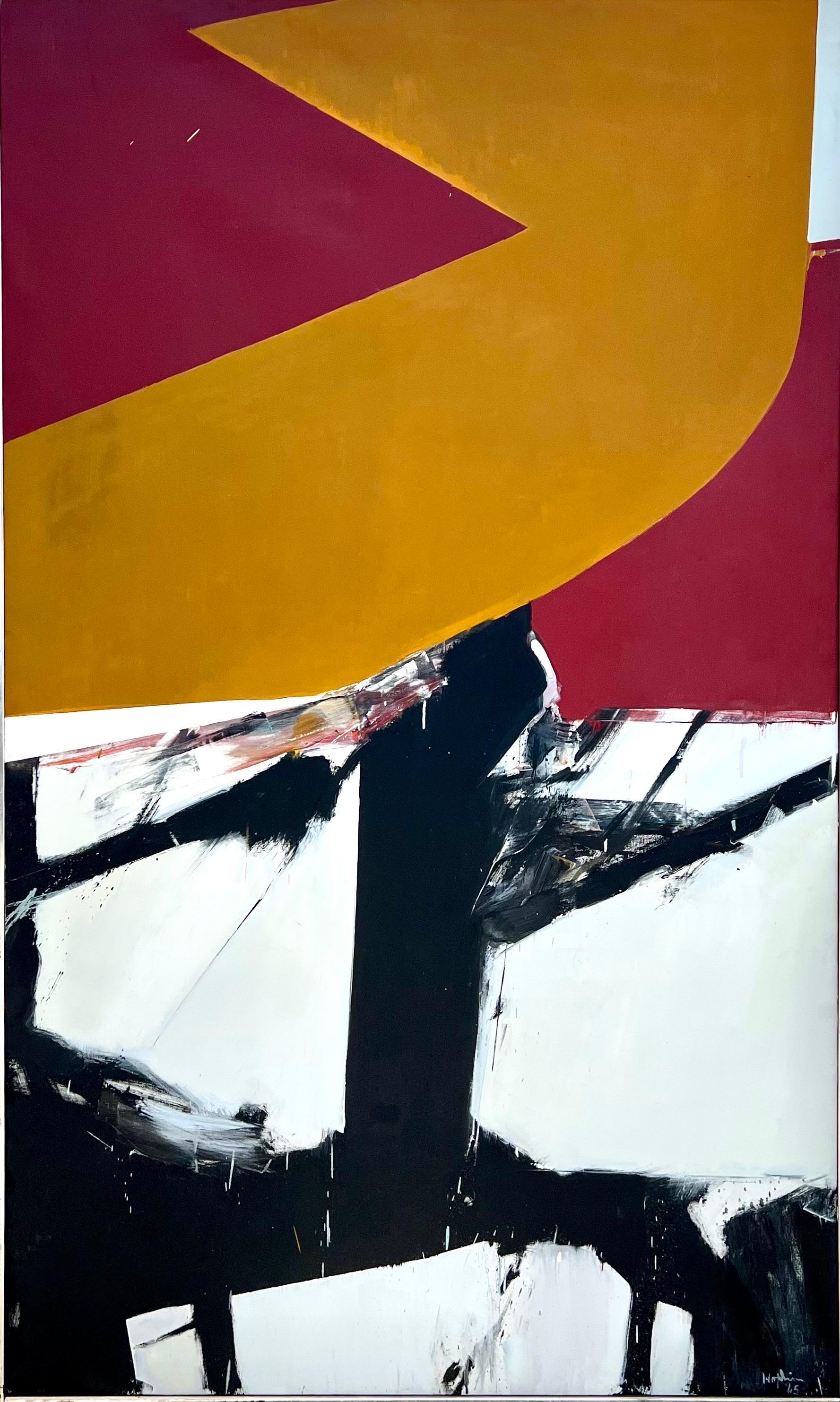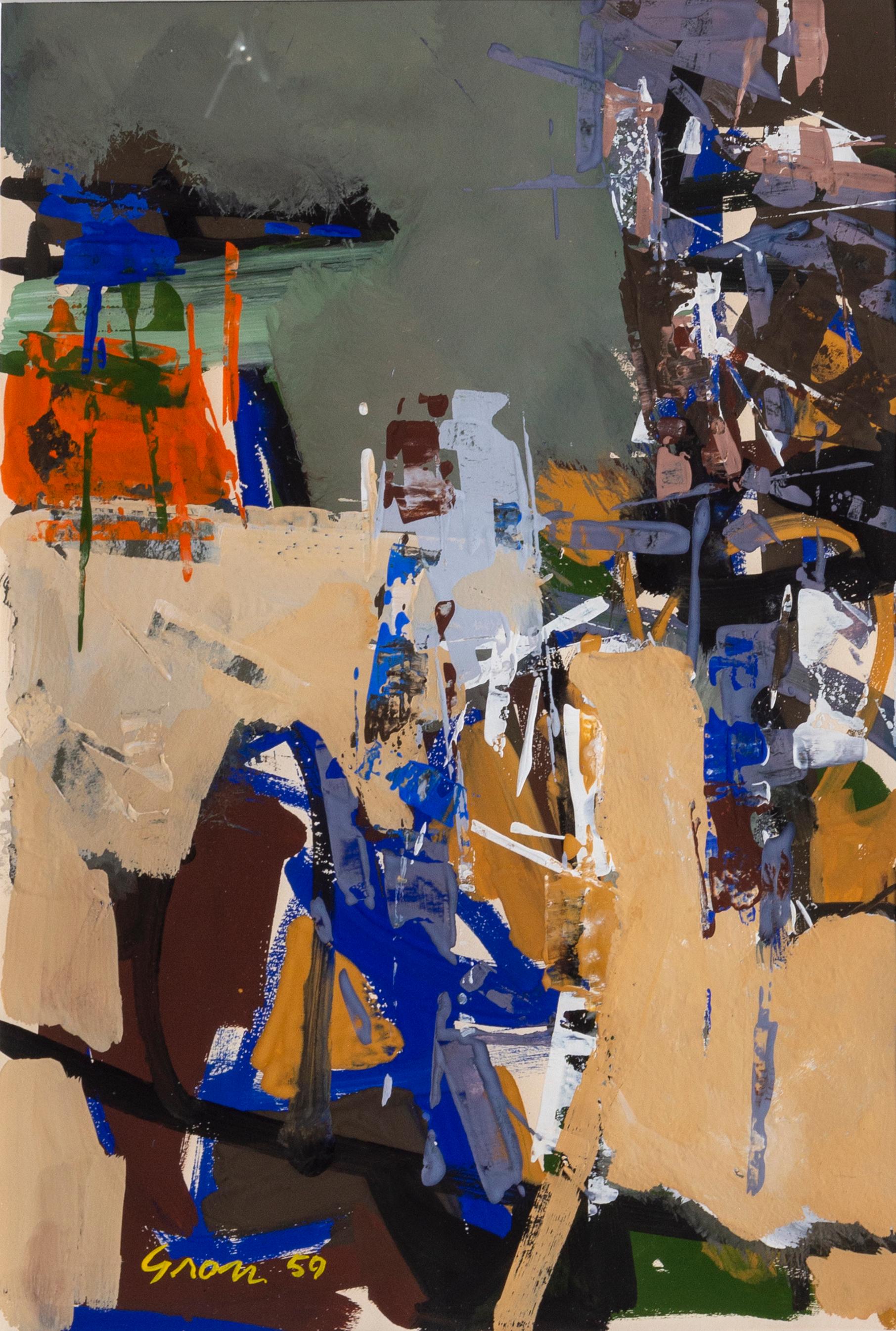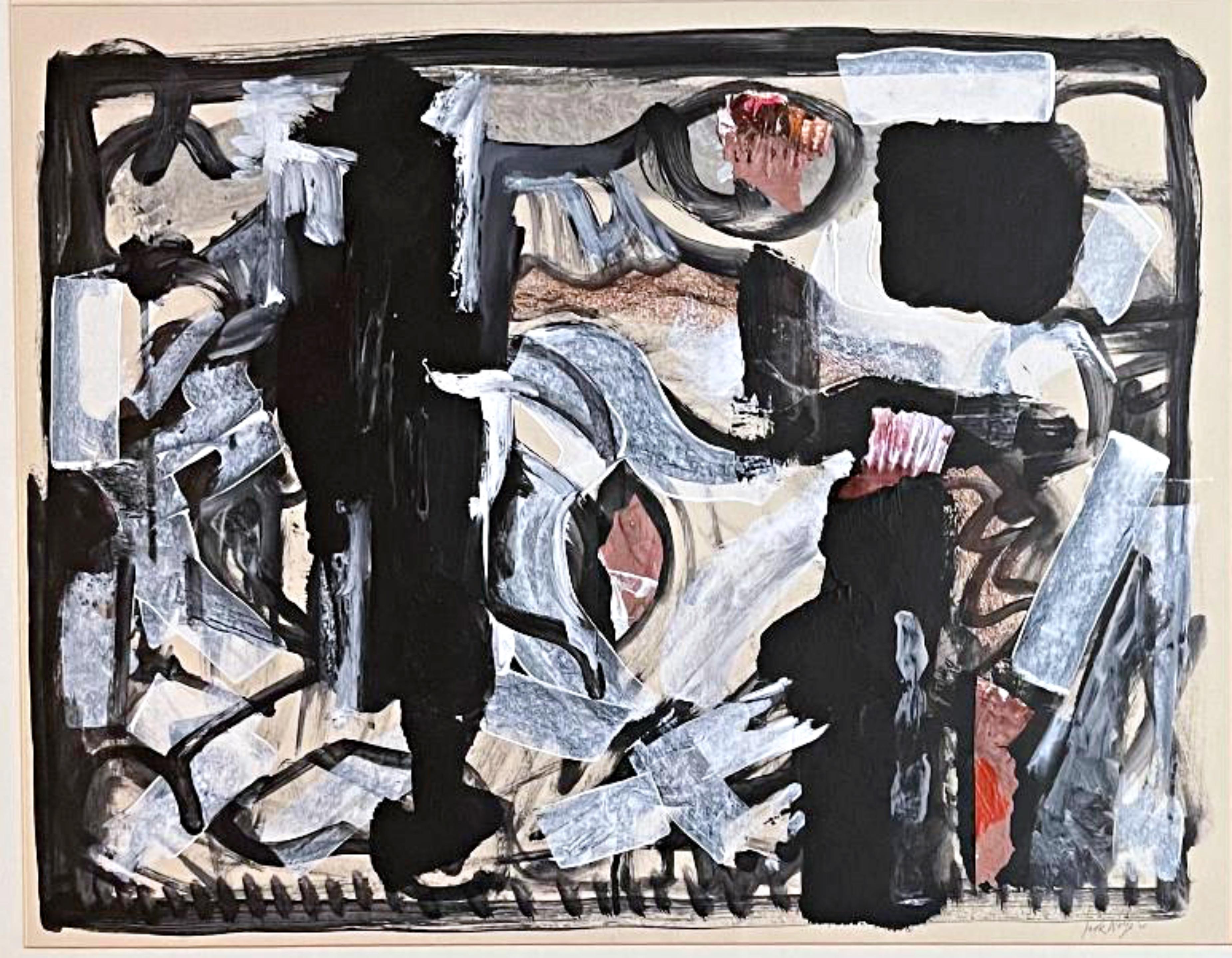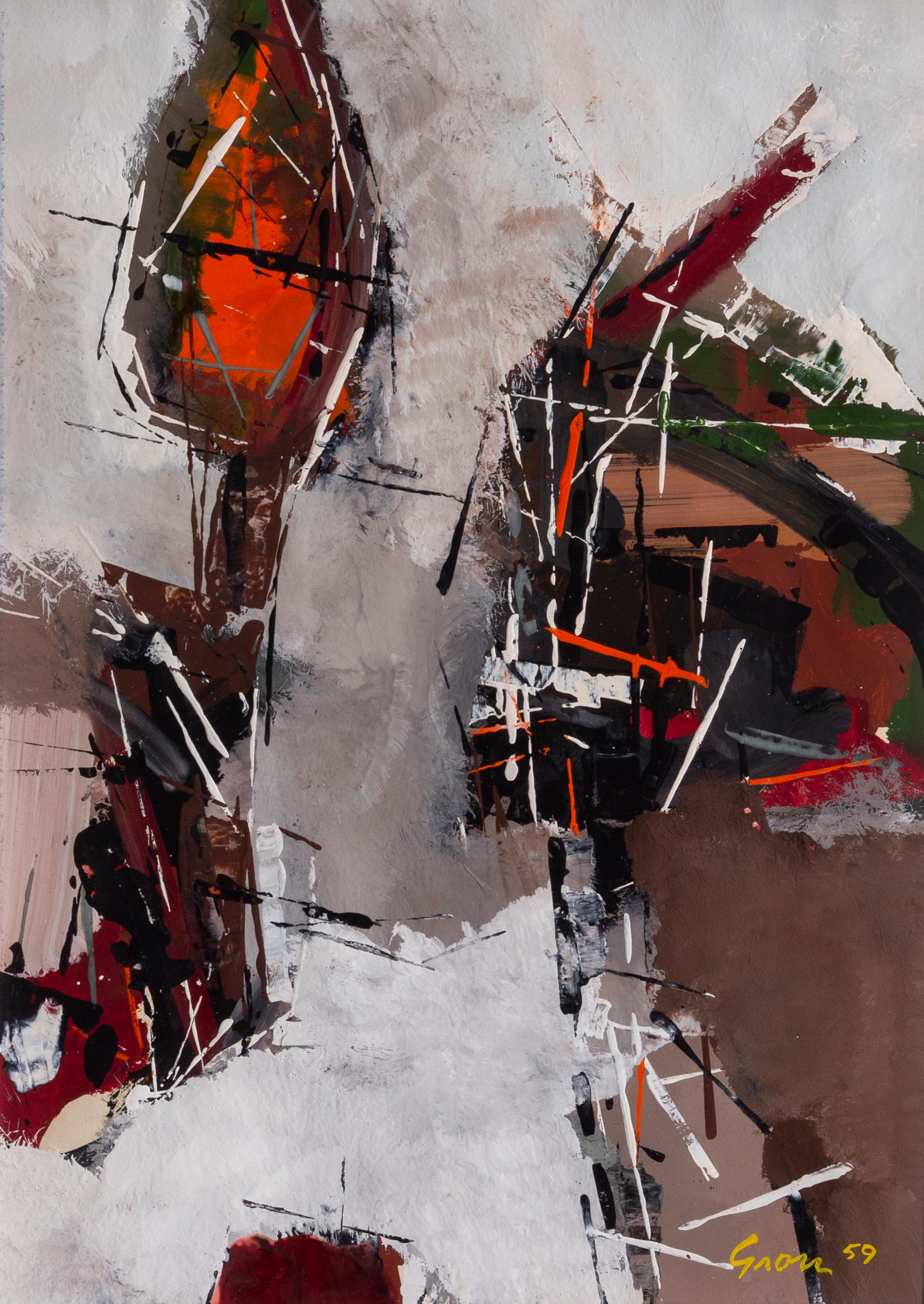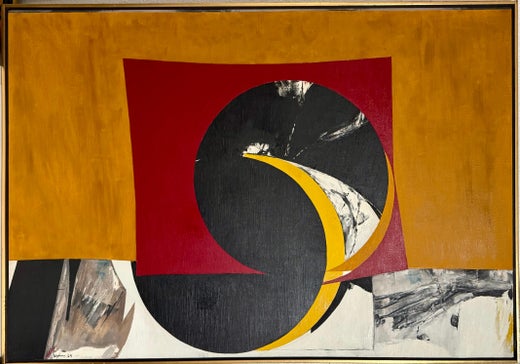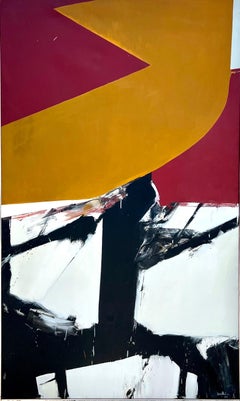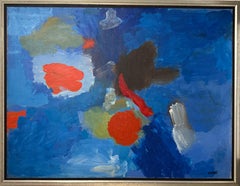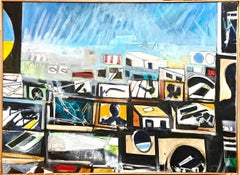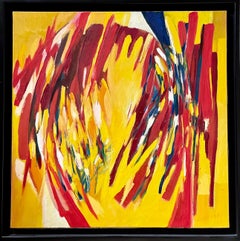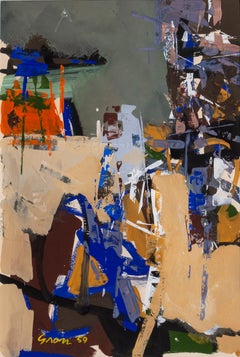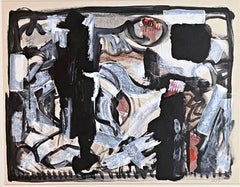Items Similar to Large Budd Hopkins Modernist Hard Edged Abstract Expressionist Oil Painting 1965
Want more images or videos?
Request additional images or videos from the seller
1 of 16
Budd HopkinsLarge Budd Hopkins Modernist Hard Edged Abstract Expressionist Oil Painting 19651969
1969
$16,000
£12,035.84
€13,942.96
CA$22,556.69
A$25,084.54
CHF 13,166.03
MX$305,893.92
NOK 166,392.52
SEK 155,999.62
DKK 104,068.56
About the Item
Budd Hopkins, American (1931-2011)
'City Sun II',
1969
Oil painting on canvas.
Hand signed and dated lower left.
Verso: Artist, title, and year in pencil on stretcher. Dimensions: 36" H x 52" w. Frame: 37.25" h x 53.25" w.
Budd Hopkins was one of the leading proponents of the "hard-edge" abstract minimalist school of painting in the 1950s and 1960s, Budd Hopkins (born 1931) created works that show the strong influence of Jackson Pollock and other leading painters of the Abstract Expressionism movement. Hopkins' paintings are now in numerous major collections, including the San Francisco Museum of Art, the Guggenheim Museum in New York, and the Hirshhorn Collection in Washington, DC.
Recently, he has also been recognized for his research into the matter of UFOs and one of his books, "The Intruders", printed by Random House, was on the New York Times best-seller list and was the basis for a television show on CBS.
Born in 1931, he is a graduate of Linsly Military Institute (now Linsly School) in 1949 and Oberlin College in 1953. He first displayed artistic abilities when, as a child recovering from a long-term illness, he began to create sculptures of ships made out of modeling clay. But it wasn't until he arrive at Oberlin that he made a serious study of art. Later, Hopkins included abstracted figures in his sculptural pieces. While moving away from Abstract Expressionism, Hopkins retained in his work the use of intense colors and hard-edged forms. His works of the 1980s, including Temples and Guardians, featured these "sentinels" who were, according to Hopkins, "participating in a frozen ritual, fixed – absolutely – within a privileged space..." Though Hopkins denied any connection, some critics viewed these ritualistic pieces as an extension of Hopkins' fascination with alien beings. Hopkins viewed his sculpted guardians not as human per se, but as magical, fierce, noble robots of the unconscious.
He settled in New York after obtaining his degree and has had a residence there ever since. He and his wife, April Kingsley, and their daughter, Grace, divide their time between their home at Cape Cod, Mass., and that in New York City. In his work, he travels widely. He has exhibited in England, Finland, Italy and Switzerland.
In 1963, Hopkins was selected by the Columbia Broadcasting System as one of the 15 painters featured in the network's first television special on American art. In 1958, Art News picked him as one of 12 Americans for exhibition in Spoleto, Italy, in the "Festival of Two Worlds."
His brilliance has won him a number of fellowships and awards. In 1972, the West Virginia Arts and Humanities Council awarded him its Commission Prize. In 1976, he received the John Simon Guggenheim Fellowship for Painting and in '79 he received a fellowship from the National Endowment of the Arts. He also won a special project grant from the New York State Council on the Arts in 1982. He was friends with Robert Ryman and many of the other 10th street avant garde artists. He was an original member of March Gallery which showed Alice Baber, Elaine de Kooning, Mark di Suvero, Lester Johnson, Matsumi Kanemitsu.
His work was handled by Poindexter Gallery. (a major gallery founded in 1955 in New York City by Elinor Poindexter. The gallery specialized in sculpture, abstract, and figurative art and featured the works of such artists as Richard Diebenkorn, Jules Olitski, Nell Blaine, Al Held, Willem de Kooning, Franz Kline, Earl Kerkam, Milton Resnick and Robert De Niro, among others.
His art has been featured in the Metropolitan Museum of Art, Museum of Modern Art, Bronx Museum of Art, Brooklyn Museum, Whitney Museum, Corcoran Gallery, Guggenheim Museum, Queens Museum in New York, and the Public Library of New York. He was included in Young America 1960: Thirty American Painters Under Thirty-Six buy Lloyd Goodrich at the Whitney Museum of American Art in NYC. Artists included: Sonia Gechtoff, Edward Giobbi, Ron Gorchov, James Harvey, Budd Hopkins, Wolf Kahn, Alex Katz, Robert Natkin, Rudy Pozzatti, Dean Richardson, Frank Roth, William Wiley, and Noriko Yamamoto.
He was included in American Abstract Artists 50th Anniversary Print Portfolio and included The ART in Embassies Exhibition at the U.S. Embassy in Nassau along with Richard Anuszkiewicz, Nassos Daphnis, Ellsworth Kelly, Ibram Lassaw, Roy Lichtenstein, Robert Motherwell and Joel Shapiro. Universities and Colleges which have shown Hopkins paintings and sculpture include his alma mater, Oberlin; Princeton, Yale, Denison, Drew, Massachusetts Institute of Technology, DePauw, Williams, Brandeis, Middlebury, North Carolina, Michigan State, Reed, Bradford, Connecticut, Alabama, Bennington, and the City College of New York,
- Creator:Budd Hopkins (1931 - 2011, American)
- Creation Year:1969
- Dimensions:Height: 37.25 in (94.62 cm)Width: 53.25 in (135.26 cm)Depth: 2 in (5.08 cm)
- Medium:
- Movement & Style:
- Period:
- Condition:frame has wear.
- Gallery Location:Surfside, FL
- Reference Number:1stDibs: LU38216250392
Budd Hopkins' paintings in the 1960s combined the precise, hard-edge geometric shapes he was enthralled with and drawn to as a child with gestural, atmospheric painting characteristic of second- and later-generation Abstract Expressionists. "I had come to understand that an abstract painting at its most powerful was a kind of aesthetic scrim behind which lurks a concealed, obsessive 'thing' or image of some kind, transformed, made palatable by the artist's mediating skills." Hopkins viewed collage as an artistic technique and a philosophical, aesthetic means of unifying a disjointed and fragmented world. He saw collage, the assemblage of fragments and varying points of view, in the poetry, painting, sculpture, music, architecture, and, especially, motion pictures of his day: "Consciously or unconsciously, contemporary artists work to create harmony from distinctly jarring material, forcing warring ideas, materials and spatial systems into a tense and perhaps arbitrary detente. Seen most broadly, the presence of the collage aesthetic is the sole defining quality of modernism in all the arts." Hopkins worked to achieve harmony, clarity and precision while maintaining a sense of mystery: "I like neither extreme in art wholeheartedly, neither the purified world of geometrical art nor the free, indulgent world of Expressionism." In 1963, Hopkins' work was included in American Painters, a film documentary of American artists and styles with commentary from Alfred Barr of the Museum of Modern Art, Thomas Hess of Art News Magazine, Sidney Janis, gallery director, and Harold Rosenberg, art critic. Later, Hopkins included abstracted figures in his sculptural pieces. While moving away from Abstract Expressionism, Hopkins retained in his work the use of intense colors and hard-edged forms. His works of the 1980s, including Temples and Guardians, featured these "sentinals" who were, according to Hopkins, "participating in a frozen ritual, fixed – absolutely – within a privileged space…" Though Hopkins denied any connection, some critics viewed these ritualistic pieces as an extension of Hopkins' fascination with alien beings. Hopkins viewed his sculpted guardians not as human per se, but as magical, fierce, noble robots of the unconscious. Hopkins exhibited his paintings and sculptures in museums, galleries such as Andre Zarre, Levis Fine Art and Poindexter (New York) and Jan Cicero (Chicago), and universities throughout the United States. Hopkins had a major retrospective exhibition at the Provincetown Art Association and Museum in the summer of 2017. The Whitney Museum, Washington Gallery of Modern Art, Metropolitan Museum of Art, Museum of Modern Art, Corcoran Gallery of Art, the British Museum, include Hopkins' work in their permanent collections.
About the Seller
4.9
Platinum Seller
Premium sellers with a 4.7+ rating and 24-hour response times
Established in 1995
1stDibs seller since 2014
1,794 sales on 1stDibs
Typical response time: <1 hour
- ShippingRetrieving quote...Shipping from: Surfside, FL
- Return Policy
Authenticity Guarantee
In the unlikely event there’s an issue with an item’s authenticity, contact us within 1 year for a full refund. DetailsMoney-Back Guarantee
If your item is not as described, is damaged in transit, or does not arrive, contact us within 7 days for a full refund. Details24-Hour Cancellation
You have a 24-hour grace period in which to reconsider your purchase, with no questions asked.Vetted Professional Sellers
Our world-class sellers must adhere to strict standards for service and quality, maintaining the integrity of our listings.Price-Match Guarantee
If you find that a seller listed the same item for a lower price elsewhere, we’ll match it.Trusted Global Delivery
Our best-in-class carrier network provides specialized shipping options worldwide, including custom delivery.More From This Seller
View AllLarge Budd Hopkins Modernist Hard Edged Abstract Expressionist Oil Painting 1965
Located in Surfside, FL
Budd Hopkins, American (1931-2011)
Strike Red
Oil on canvas, 1965, signed 'Hopkins' and dated lower right.
Dimensions: 85 x81 in., 86 x 52 in. with frame.
Provenance: bears partial label remnant verso from Poindexter Gallery. (a major gallery founded in 1955 in New York City by Elinor Poindexter. The gallery specialized in sculpture, abstract, and figurative art and featured the works of such artists as Richard Diebenkorn, Jules Olitski, Nell Blaine, Al Held, Willem de Kooning, Franz Kline, Earl Kerkam, Milton Resnick and Robert De Niro, among others.
Budd Hopkins was one of the leading proponents of the "hard-edge" abstract minimalist school of painting in the 1950s and 1960s, Budd Hopkins (born 1931) created works that show the strong influence of Jackson Pollock and other leading painters of the Abstract Expressionism movement. Hopkins' paintings are now in numerous major collections, including the San Francisco Museum of Art, the Guggenheim Museum in New York, and the Hirshhorn Collection in Washington, DC.
Recently, he has also been recognized for his research into the matter of UFOs and one of his books, "The Intruders", printed by Random House, was on the New York Times best-seller list and was the basis for a television show on CBS.
Born in 1931, he is a graduate of Linsly Military Institute (now Linsly School) in 1949 and Oberlin College in 1953. He first displayed artistic abilities when, as a child recovering from a long-term illness, he began to create sculptures of ships made out of modeling clay. But it wasn't until he arrive at Oberlin that he made a serious study of art. Later, Hopkins included abstracted figures in his sculptural pieces. While moving away from Abstract Expressionism, Hopkins retained in his work the use of intense colors and hard-edged forms. His works of the 1980s, including Temples and Guardians, featured these "sentinels" who were, according to Hopkins, "participating in a frozen ritual, fixed – absolutely – within a privileged space..." Though Hopkins denied any connection, some critics viewed these ritualistic pieces as an extension of Hopkins' fascination with alien beings. Hopkins viewed his sculpted guardians not as human per se, but as magical, fierce, noble robots of the unconscious.
He settled in New York after obtaining his degree and has had a residence there ever since. He and his wife, April Kingsley, and their daughter, Grace, divide their time between their home at Cape Cod, Mass., and that in New York City. In his work, he travels widely. He has exhibited in England, Finland, Italy and Switzerland.
In 1963, Hopkins was selected by the Columbia Broadcasting System as one of the 15 painters featured in the network's first television special on American art. In 1958, Art News picked him as one of 12 Americans for exhibition in Spoleto, Italy, in the "Festival of Two Worlds."
His brilliance has won him a number of fellowships and awards. In 1972, the West Virginia Arts and Humanities Council awarded him its Commission Prize. In 1976, he received the John Simon Guggenheim Fellowship for Painting and in '79 he received a fellowship from the National Endowment of the Arts. He also won a special project grant from the New York State Council on the Arts in 1982. He was friends with Robert Ryman and many of the other 10th street avant garde artists. He was an original member of March Gallery which showed Alice Baber, Elaine de Kooning, Mark di Suvero, Lester Johnson, Matsumi Kanemitsu.
His art has been featured in the Metropolitan Museum of Art, Museum of Modern Art, Bronx Museum of Art, Brooklyn Museum, Whitney Museum, Corcoran Gallery, Guggenheim Museum, Queens Museum in New York, and the Public Library of New York. He was included in Young America 1960: Thirty American Painters Under Thirty-Six buy Lloyd Goodrich at the Whitney Museum of American Art in NYC. Artists included: Sonia Gechtoff, Edward Giobbi, Ron Gorchov, James Harvey, Budd Hopkins, Wolf Kahn, Alex Katz, Robert Natkin, Rudy Pozzatti, Dean Richardson...
Category
1960s Abstract Expressionist Abstract Paintings
Materials
Paint
Large Abstract Expressionist Oil Painting on Canvas John Von Wicht WPA Artist
Located in Surfside, FL
John von Wicht (German American, 1888-1970)
"On Blue"
1964
Oil and acrylic on canvas
Hand signed lower right "V. Wicht",
Hand signed, titled, and dated on the stretcher "1964-66"
D...
Category
1960s Abstract Expressionist Abstract Paintings
Materials
Oil, Canvas, Acrylic
Large John Hultberg SF Bay Area Artist Abstract Expressionist Oil Painting
By John Hultberg
Located in Surfside, FL
John Hultberg
Oil on canvas
Panorama of pictures. 1998
Hand signed lower right, J. Hultberg ‘98.
Artist, date, and title written on verso.
Canvas 25.5”H x 35”W, Frame 26”H x 35.5”...
Category
1990s Abstract Expressionist Abstract Paintings
Materials
Canvas, Oil
1960's Large Colorful Abstract Expressionist Swiss Oil Painting Robert Lauro
Located in Surfside, FL
Oil Painting on canvas
Hand signed to lower right Lauro.
Provenance: Eleonore Austerer Gallery, San Francisco, CA
Work Size: 39.5 x 39.5 in. framed 44 X 44 inches.
Roberto Lauro is a British-Swiss Post War & Contemporary artist who was born in 1932.
Roberto Lauro was born in 1932 in Gorey Harbor on the island of Jersey (Great Britain) the son of a Swiss mother, Rosa Ramseier, from Oberdiessbach / Emmental, Switzerland, and and Italian father Innocenzo Roberto Lauro, born in Mondovi, Italy. In 1941 he moved to Switzerland with his mother. 1949-1953 he lived in Gunten (Switzerland) where he did an Apprenticeship as a lithograph and offset printer and graphic designer in Thun. There he was introduced to the color theory of Johannes Itten by Hermann Oberli at the Bern School of Applied Arts. From 1953 to 1955 he worked as a fine art printer in Norway where he was influenced by the color theory of Edvard Munch. These works bears the influence of Russian artist Andre Lanskoy, Tachisme and the Cobra artists Karel Appel, Constant, Corneille, Christian Dotremont, Asger Jorn, and Joseph Noiret.
In 1955-1956 he worked as an offset printer in Amsterdam (Netherlands). Visit to the Instituut voor Kunstnijverheidsonderwijs. In 1957 he returned to Gunten, Switzerland. Where he started working in printmaking and and oil painting. He resumed his studies at the Bern School of Applied Arts. He was greatly impacted and influenced by abstract art on the occasion of a large Paul KIee exhibition. In 1958 he moved to Zurich where he worked part-time work as an offset copyist; fulfilling graphic orders for advertising agencies. In 1962 he took his final examination as graphic designer at the Zurich School of Applied Arts. In 1980 he begins his development of three-dimensional picture objects, Sculpture, detachment from the canvas, using metal as a support and play space for light and color. By 1981 he has turned full time to fine art. He spends the next years growing and developing his considerable talent. Inspired by classical music, the rhythm, mood and lightness of which form the basis for the large swings and loops of his colorfully lacquered metal and blown glass sculptures. These are "pensieri", thought sketches that capture the emotions in countless versions. There is something dance-like about his rotating sculptures. Everything becomes music and the rhythm of colors. In 1988, after exhibitions in Europe, he has his first exhibitions in Atlanta and San Francisco (USA), In 1989 he does his first glass and metal sculptures at the Roberto Niederer glassworks, Hergiswil (Switzerland). In 1992 has a retrospective exhibition in the Tan Gallery, Zurich, and the Eleonore Austerer Gallery, San Francisco. They Publish a catalogue raisonne, Eine Retrospektive, covering a 45 year career. In 1993 he creates A Retrospective, a unique sculpture in a table top form that contains his catalogue raisonne and an original lithograph.
1993–1995 he begins work on a number of large scale public outdoor commissions, including Light Columns for a Bank building, and a commission of a sculpture-fountain in Oetwil am See. In 2001 he creates a wall sculpture entitled "Color Poems of the Yearly Cycle. A linen bound book enclosed in a unique plexi display with a one - of a - kind metal and glass sculpture,containing 12 linocuts each printed in colors and signed.
Roberto Lauro's sculptural work work is spontaneous and loaded with energy. The furrows, rifts, cracks and scars in the metal allow light to enter; it is then reflected back by the glass. His work is a clear statement of our times, uniting the intellect and the heart in search of the spiritual. Like the interplay of light and shadow, his sculpture combines fragile, transparent glass with solid, heavy iron. These colorful and luminous sculptures convey a powerful presence and emit vibrant positive energy. With their jagged exteriors and translucent cores, the spectacular sculptures created by the synergy of metal and glass are powerful - yet fragile. Lauro has created and mastered his own idiom and proven that through the artist sheer will and vision, seemingly incompatible materials such as iron and glass can indeed be combined. In 2004 he has an anniversary exhibition Light and Color, Love of Life on the island of birth, Jersey. Ceramic works (raku with glass inclusions). Roberto Lauro's works have been shown in numerous exhibitions in Europe and the USA around the world, and he has also realized projects such as "KUNST AM BAU" in public spaces and for industry. He lives and works in Switzerland.
Select Exhibitions
Eleonore Austerer Gallery, Palm Desert
ART IN THE FRAME FOUNDATION: The Harbour Gallery, Isle of Jersey
Galerie fur Gegenwartskunst,, Bonstetten, Switzerland
Galerie Annamarie Anderson, Zurich, Switzerland
“Color and Light,” Austerer-Crider Gallery, Palm Springs, CA, USA
“Color and Light: the art of Roberto Lauro,” Eleonore Austerer Gallery, San Francisco, CA, USA
“Flower Power,” with Ed Baynard, Roberto Azank, Siegward Sprotte, and Daniel Phil...
Category
1960s Abstract Expressionist Abstract Paintings
Materials
Canvas, Oil
Large Modernist Abstract Painting (1of 2 available)
By Gregg Robinson
Located in Surfside, FL
Gregg Robinson, American (born 1948) "Cipher Bar 20" Oil on Canvasboard Panel. Artist signed, title and dated 1990 far right. Very minor rubbing to paint. Panel measures 15-1/4" H x 63-1/2" W, frame measures 24-1/4" H x 72-1/4"
GREGG ROBINSON
The universe of visual art encompasses a huge spectrum of motivation and means of expression. Examples range from the most syrupy sentimentality to extremes of moral and intellectual confrontation. For me, the creative process is, on the simplest level, an aesthetic puzzle. Elements of the puzzle include contrast, color, visual texture, graphic pattern, and in some recent work, a simple cryptic symbolism.
I have never been particularly interested in lyric or pictorial content, and though some of my work does contain undeniable spatial illusion, even that tends to be a by-product rather than a goal of the primary pursuit: the balance of light and dark, pure color and organic neutrals, energy and calm, strong pattern and subtle field. Having grown up in an environment of contemporary architecture, I have always valued the classic modern synthesis of form and function exemplified by the Bauhaus movement of the early 20th century. Hence, the simplest solutions are often the most satisfying. Obviously, the modernist ideal of efficiency in form and function requires that method of execution be as well adapted to the aesthetic goal as the visual language itself.
The media before you is the result of many years of experimentation that came to its current form in early 1992. I work with dry pigment over a plaster surface. My tools are broad knives, sponges, rags and masking. The finish is a high gloss alkyd resin.
CORPORATE COLLECTIONS:
Allstate Insurance
NBC Productions
Alaska...
Category
1990s Contemporary Abstract Paintings
Materials
Canvas, Mixed Media, Oil, Board
1974 California Bay Area Abstract Expressionist Bold Oil Painting Don Clausen
By Don Clausen
Located in Surfside, FL
Don Clausen American (b. 1930)
Untitled (1974)
Oil on board
Hand signed lower left and verso
Framed 11.25 X 13.5 sight 9 x 11.25 inches
Don Clausen is an American Postwar & Contem...
Category
1970s Abstract Expressionist Abstract Paintings
Materials
Oil, Board
You May Also Like
Scottish Abstract - Exhibited 1965 Abstract Expressionist art oil painting
Located in London, GB
This very striking exhibited Scottish Abstract oil painting is by influential Scottish artist Jack Knox. Painted in 1964, it is a vivid mix of autumnal colours, textures and brushwork that work perfectly. A brilliant example of his work from the early sixties and which was exhibited at the Royal Scottish Academy in 1965.
Titled and dated 21.2.64 lower right.
Provenance. Exhibited Royal Scottish Academy, Exhibition 1965, Edinburgh.
Condition. Oil on canvas, 51 inches by 36 inches unframed and in good condition.
Housed in a gilt sixties surround frame, 53 inches by 38 inches framed and in good condition.
Jack Knox RSA (1936-2015) was one of the most influential artists to work in Scotland in the second half of the twentieth century. Born John Knox to a family of tailors in Kirkintilloch, Knox studied at the Glasgow School of Art (1953-57) where his drawings were noted for their mature draughtsmanship. After graduating, Knox went to Paris to attend the atelier of Cubist artist, André L’Hȏte. During his time in Europe Knox digested the various art movements of the moment, including Surrealism, Tachisme, Colour Field and Pop Art. Visiting the great museums, he was particularly interested in Analytic Cubism and Georges Braque’s intimation, rather than description, of object. He also went to Brussels to visit the first major show of American Abstract Expressionism in Europe. He returned to Scotland eager to establish his own style, drawing on everything he had seen in Europe. In 1960 the Glasgow Herald presented an exhibition during the Edinburgh Festival of young artists from the west of Scotland. Knox was selected to show alongside George Devlin, Carole Gibbons, Anda Patterson, Douglas Abercrombie and Duncan...
Category
1960s Abstract Abstract Paintings
Materials
Oil
$15,490 Sale Price
20% Off
Untitled (hard-edge abstract painting)
Located in Wilton Manors, FL
Budd Hopkins (1931-2011). Abstract, 1968. Oil on canvas, 30 x 52 inches; 31 x 53 inches framed. Signed and dated lower margin. Provenance: Timothy Collins (1940-2017), Palo Alto, CA...
Category
1960s Hard-Edge Abstract Paintings
Materials
Canvas, Oil
Abstract Expressionist Gouache Painting by Sid Gross 1959
By Sidney Gross
Located in Long Island City, NY
An Abstract expressionist gouache painting by American artist, Sid Gross.
Date: 1959
Gouache on paper, signed and dated lower right
Image Size: 18.5 x 12 inches
Frame Size: 28 x 22 ...
Category
1950s Abstract Expressionist Abstract Drawings and Watercolors
Materials
Gouache
Mid century Modern 1960s Abstract Expressionist painting, renowned artist Signed
Located in New York, NY
Jack Wolfe
Untitled, 1965
Acrylic and collage on board
Hand signed on the front
Frame included: held in original vintage frame with original gallery label
Unique
Provenance: Parker Street 470 Gallery, Boston, Mass (with label verso)
Excellent abstract expressionist mixed media work.
Measurements:
Image:
17" x 24"
Framed:
24" x 28" x 1"
From Wiki:
Jack Wolfe (14 January 1924 – 18 November 2007) was a 20th-century American painter most known for his abstract art, portraiture, and political paintings. Jack Wolfe was born in Omaha, Nebraska on January 14, 1924, to Blanche and Everett L. Wolfe. Soon after his birth, his family moved to Brockton, MA. At 18, Wolfe had an interest in commercial illustration, which he pursued at the Rhode Island School of Design (RISD). However, upon matriculating at RISD in 1942, he developed an interest in fine art and painting inspired by an exhibition of modern French art. He described this change of direction, explaining that, "One day, for the first time, I saw an exhibition of modern French art. It was like being struck by lightning." He became particularly interested in the work of a number of European modernists, including Rouault, Cézanne, Braque, Modigliani, and Picasso.[1] Following his time at RISD, he pursued a Master’s in Fine Arts degree at the Museum of Fine Arts School in Boston, MA. At the Museum School, Wolfe studied under the renowned Expressionist Karl Zerbe, a German-born artist who was the Museum School's most influential and vital teacher until 1953.[2] After graduating from the Museum School, Wolfe was represented by the Margaret Brown Gallery in Boston, which also represented many other cutting edge Moderns that defied the more conservative tastes of New England collectors at the time, including György Kepes, Congur Metcalf, and Alexander Calder.[3]
Career and Museum Representation
Jack Wolfe's painting "Robin's Rock" 1962, 72" x 72"
Jack Wolfe's artwork received early recognition from a number of organizations and was consistently featured in influential exhibitions, including the 1955 Carnegie International at the Carnegie Institute in Pittsburgh, PA, the American Federation of Art's traveling exhibition New Talent in the USA in 1956-57, the Whitney Museum’s Young America exhibition in 1957,[4] the Boston Institute of Contemporary Art's Selection exhibition in 1957,[5] and both the Whitney Museum’s 1958 Annual exhibition and its Forty Artists Under Forty show in 1962-63.[6] In 1959, his widely acclaimed Portrait of Abraham Lincoln toured Europe in a show circulated by the Institute of Contemporary Art, Boston. In addition, his painting Crucifixion was chosen by the United States Information Agency to be exhibited across Europe, including being shown at the Salzburg Biennial in Austria in 1958.[7] Crucifixion was also exhibited at the Whitney Museum and subsequently displayed in the National Cathedral in Washington, DC, in 1958.[8] In 1966-67, his work was selected for Art for Embassies by the U.S. State Department.[9] He received the first annual Margaret Brown Memorial Award for high achievement by a New England Artist from the Institute of Contemporary Art, Boston, in 1958.[10]
With his future as one of the great artists of his time laid out neatly before him, Wolfe moved to New York in the early 1950s, which was then the postwar epicenter of the art world and in the midst of experiencing the first real revolution in American Art, now known as Abstract Expressionism.[11] However, almost immediately upon his arrival, he became disenfranchised with the overtly commercial nature of the art scene there, spurning fame and security in an unwillingness to bend his creative vision to the expectations of others.[12] After four short months, he left New York, returned to Massachusetts where he bought property in Stoughton, cleared the land, and built both his home and studio with his own two hands. He would go on to live and paint there, extensively exhibiting and garnering constant critical acclaim.[13]
Wolfe became one of the earliest artists championed by the deCordova Museum in Lincoln, MA and the Institute of Contemporary Art in Boston. He was awarded a traveling scholarship in 1958,[6] which allowed him to set up studio in San Miguel de Allende, Mexico and then in San Francisco, California.[14] Upon his return in 1959, the deCordova museum hosted Wolfe’s third solo exhibition, featuring work made during his time in California...
Category
1960s Abstract Expressionist Abstract Paintings
Materials
Mixed Media, Acrylic, Gouache, Permanent Marker
Abstract Expressionist Gouache Painting by Sid Gross 1959
By Sidney Gross
Located in Long Island City, NY
An Abstract expressionist gouache painting by American artist, Sid Gross.
Date: 1959
Gouache on paper, signed and dated lower right
Image Size: 18.5 x 12 inches
Frame Size: 28 x 22 ...
Category
1950s Abstract Expressionist Abstract Drawings and Watercolors
Materials
Gouache
Mid Century French abstract oil on canvas by Jean Maurice Lasnier
Located in Petworth, West Sussex
Jean Maurice Lasnier (French, 1922 – 2006)
Tempete Industrielle
Signed ‘LASNIER’ (lower left)
Oil on canvas
25.3/4 x 32 in. (65.4 x 81cm.)
Provena...
Category
20th Century Abstract Expressionist Abstract Paintings
Materials
Canvas, Oil
More Ways To Browse
Best Sellers
Dean West
James Childs Painting
Oil Paintings Cape Cod
James Dean Artist
Used Bennington
Painting Oil Earl
Reed Oil Painting
William Temple
Ellsworth Kelly Signed
Grace Kelly Signed
Ufo Art
Richard Temple
James Dean Vintage
Vintage Alien Art
Vintage House Of Lloyd
Robot Sculpture
Expressionist Clay Sculpture
